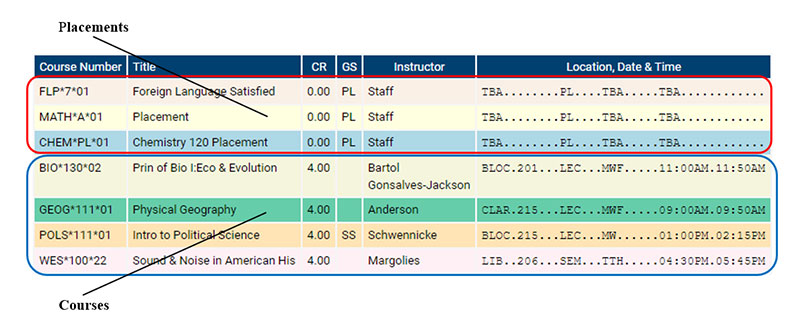There are two categories of information on your schedule, your courses and your placements.

Placements
Placements indicate the level of courses you must take to satisfy the General Education requirement for math and foreign language as well as whether you are prepared to take CHEM 120.
The CHEM placement only applies if you want to take CHEM 120.
You do not have to take CHEM 120, unless it is required for your major or if you want to. Generally, only science majors take CHEM 120 since it is a very challenging and demanding course.
Placements are easy to identify because they say PL under the GS (General Studies) column.
Placements only appear on your schedule the first semester you enroll at VWU. After that, they appear on your Academic History in WebAdvisor.
For more information on what your specific placements mean, please see the information about Placements at the bottom of our Course Schedule web page.
Courses
Courses are the classes that you’ll actually be taking.

Course Number
Department code: Each academic department has its own code. View the list of codes.
Course number: The course number refers to the specific course. The first digit represents the level of difficulty of the course.
While it is sometimes suggested that 100 level courses are for first year students, 200 level courses are for sophomores, and so on, this is not actually true. Instead, the course level indicates the difficulty of the course and the amount of work that is required in it. Many first year students take 200, and even occasionally 300, level courses. Likewise most sophomores, and even some juniors and seniors, take 100 level courses.
Section number: Many courses have multiple sections each semester, and the section number denotes which specific class of a given course you are enrolled in. You only attend the class for the section you are enrolled in. For example, there are 23 sections of WES 100 this fall. The student in this sample schedule is enrolled in section 22 of Wesleyan 100 and therefore only attends WES 100 from 4:30-5:45 on Tuesdays and Thursdays.
Title
Course title: Every class has a specific title; however, when discussing your classes and schedule with your advisor, instructors, or other administration, we usually refer to a class by its department code and course number.
CR
Number of credits: Most courses are four credits, though some are two or three. Remember, taking four, four credit courses for four years (eight semesters) will gain you enough credits to graduate.
GS
General education code: Courses that satisfy a General Education requirement have a code denoting which requirement they fulfill. More information on the General Education curriculum can be found on the Academic Requirements page.
CA – creative arts
HUM – humanities
MN – math
LAB – natural science with laboratory
SS – social sciences
PS – professional studies
Location, Date, & Time
Class location: classes usually meet in one of the buildings on campus, but there are classes that meet in off campus or in remote, online, or other virtual formats. View the full list of meeting location codes.
Course type: Courses are designated by different types of instruction. These are general designations and do not fully define the delivery of all course materials. Almost all courses have a variety of lecture, discussion, projects, and other types of instruction.
LEC – lecture
LAB – required lab component
PL – placement information (not an actual class)
SEM – seminar
Days: The days of the week your course meets.
Times: The start and end time of your course.

